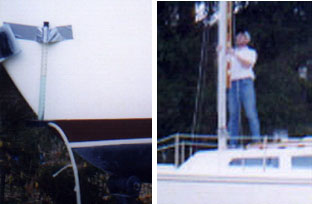Back to Technical Tips Back to Planned Projects Home
Checking the rake on your mast . . .
Checking the Mast Rake can be done easily while the boat is on the trailer using the following procedure . . .

1) Using a Water Level (can be obtained from your local building supply center), you set each cylinder of the water level to be even with the boot stripe on the bow and stern. I temporarily attach the level to the boat, in a position that is even with the boot stripe, using a piece of duct tape.
2) Then, with the water level attached to the boat, I use the jack on the trailer to level the boat (as if it were sitting level in the water). I then secure the trailer in that position.
3) I take a 4 foot level and hold it up along side the mast to check the level. Holding the top of the level to the mast, you should have a gap of about 1 inch at the bottom in order to achieve level (this is about 2-3 degrees of rake). The larger the gap, the more rake you have. Alternatively, instead of using a 4 foot level, I could hang a plumbob from the top of the mast and look for it to touch the deck at a point behind the mast (about 3" behind for every 10 feet of mast height).
My mast, when checked, had hardly any rake at all, which explains the boat's leeward helm. Given that there is no room to adjust on the turnbuckles, I will have to consider shortening the backstay a little in order to achieve proper rake.
![]() Rather than shortening the backstay, I came accross a better
approach to adding adjustment capability back into the rig -
raise the mast slightly (1/2" - 3/4"). This has the net
effect of shortening the stays, but avoids the messy (expensive)
job of cutting and re-swagging the rigging. See my Mast Plate page for a picture of the 3/4" shim I made to go
under the mastplate/tabernackle.
Rather than shortening the backstay, I came accross a better
approach to adding adjustment capability back into the rig -
raise the mast slightly (1/2" - 3/4"). This has the net
effect of shortening the stays, but avoids the messy (expensive)
job of cutting and re-swagging the rigging. See my Mast Plate page for a picture of the 3/4" shim I made to go
under the mastplate/tabernackle.